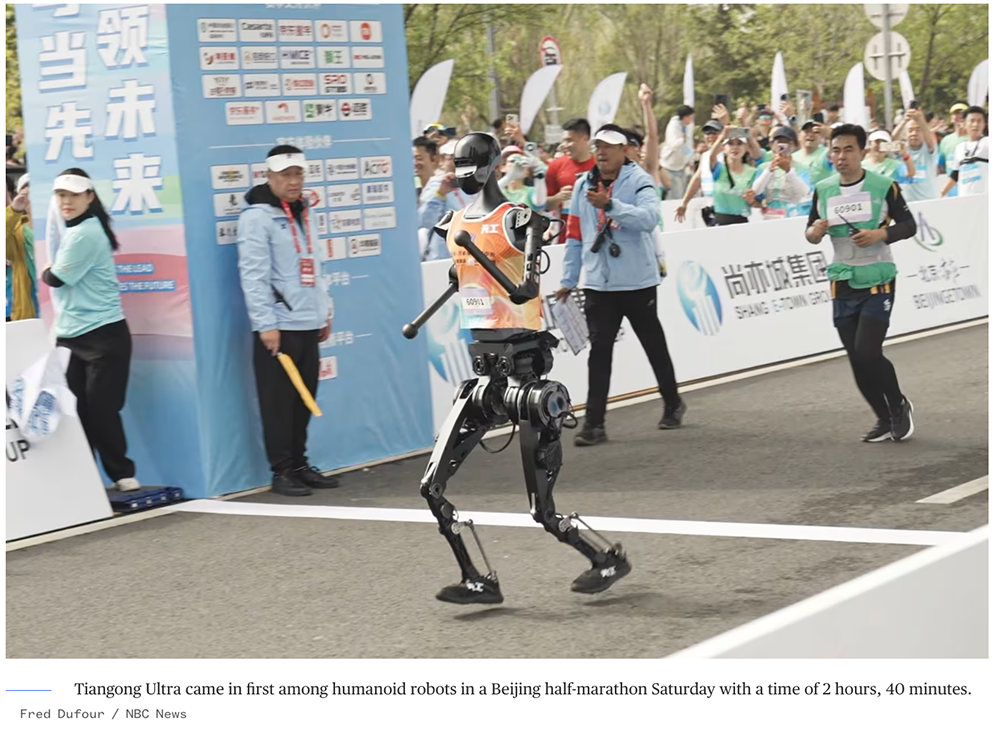China’s Humanoid Robots Race to the Future: A Half-Marathon Showdown
4/26/20254 min read


China’s Humanoid Robots Race to the Future: A Half-Marathon Showdown
April 25, 2025 | Beijing, China
In a spectacle that blended futuristic ambition with human grit, 21 humanoid robots laced up (or powered up) alongside flesh-and-blood runners for a half-marathon in Beijing last weekend. The event wasn’t just a test of endurance—it was a bold statement of China’s growing prowess in robotics and its fierce tech rivalry with the United States. From robots that dance and spin to those that, well, faceplanted at the starting line, the race was equal parts inspiring and humbling. Let’s dive into what this quirky marathon reveals about the state of humanoid robotics and China’s high-stakes tech race.
A Leap Forward for Chinese Robotics
China’s internet is buzzing with videos of sleek humanoid robots performing roundhouse kicks, twirling in sync, or navigating obstacle courses with eerie precision. Companies like UBTech, Agibot, and Unitree are pushing the boundaries of what robots can do, fueled by massive government investment and a national drive to lead in artificial intelligence and automation. These aren’t just toys—they’re designed for real-world applications, from factory floors to eldercare.
The Beijing half-marathon was a chance to showcase this progress. Robots ran (or rolled) alongside humans in a 21-kilometer course, drawing cheers from spectators and stoking national pride. For a country racing to outpace the U.S. in emerging technologies, the event was a symbolic milestone. But as the starting gun fired, it became clear that China’s robots, while impressive, still have a long way to go.
Stumbles at the Starting Line
The race wasn’t all smooth circuits and victory laps. Some robots struggled to keep up—or even get started. One humanoid, designed to resemble a woman, collapsed seconds into the race, prompting a team of engineers to swarm in with laptops like paramedics. Another, mounted on a propeller-driven platform, veered off course and crashed into a barrier. A pint-sized robot, barely taller than a toddler, suffered a glitch and dramatically flopped onto the pavement at the starting line.
These mishaps, while amusing, highlight the technical hurdles still facing the industry. Humanoid robots require complex integration of AI, sensors, and mechanical systems to navigate unpredictable environments like a marathon course. Uneven terrain, sudden obstacles, and the need for real-time decision-making pushed many of these machines to their limits. Yet, the fact that 21 robots even attempted the race is a testament to how far China’s tech sector has come.
The Bigger Picture: China vs. the World
The Beijing half-marathon is more than a quirky news story—it’s a microcosm of the global tech race. China is pouring billions into robotics and AI, aiming to dominate industries that will define the 21st century. The U.S., meanwhile, boasts its own heavyweights like Boston Dynamics and Tesla, whose Optimus robot promises to revolutionize automation. Both nations are vying for supremacy, with humanoid robots as a key battleground.
What sets China apart is its scale and speed. The country’s tech ecosystem, backed by state support and a massive domestic market, allows companies to iterate quickly and deploy robots in real-world settings. From delivery bots zipping through Shanghai to robotic arms assembling cars in Shenzhen, China is building a robot-ready economy. Events like the Beijing marathon serve as both a testing ground and a propaganda win, showcasing innovation to a global audience.
What Worked—and What Didn’t
Not all robots flopped. Several models, particularly those from established players like UBTech, completed significant portions of the course, navigating crowds and obstacles with surprising agility. These successes point to advances in AI-driven locomotion and sensor technology, which allow robots to adapt to dynamic environments. For the companies involved, even partial completions are valuable data points for refining their designs.
The failures, though, were just as instructive. Collapsing robots and wayward propellers exposed weaknesses in durability, balance, and error recovery. Human runners can trip, regroup, and keep going—robots, not so much. These challenges aren’t unique to China; even U.S. firms like Boston Dynamics face similar hurdles in making humanoids reliable outside controlled settings. The marathon underscored a universal truth: building robots that rival human versatility is insanely hard.
Why It Matters
Humanoid robots aren’t just about running races—they’re about reshaping society. In China, where an aging population and labor shortages loom, robots could fill critical gaps in healthcare, manufacturing, and services. Globally, they promise to transform how we work and live, from assisting in dangerous jobs to providing companionship. But for China, the stakes are higher: leading in robotics means securing technological and economic dominance in a world increasingly defined by automation.
The Beijing half-marathon, with its mix of triumphs and tumbles, captured this tension perfectly. It was a celebration of progress, a reminder of limitations, and a glimpse into a future where robots might not just run alongside us but outpace us. For now, though, the race is as much about human ingenuity as it is about machine capability.
Looking Ahead
As China and the U.S. continue their tech showdown, humanoid robots will remain a focal point. The Beijing marathon may have been a small step (or stumble) in the grand scheme, but it’s a sign of things to come. With each iteration, robots are getting smarter, stronger, and more adaptable. The question isn’t if they’ll transform our world—it’s when.
Thought Questions:
How do you think events like the Beijing half-marathon shape public perception of robotics in China and beyond?
What are the ethical implications of developing humanoid robots that could eventually outperform humans in physical tasks?
Should governments prioritize investment in robotics over other technologies, given the potential economic and societal impacts?
Photo Credit: NBC News. Thank you.
hello@boncopia.com
+13286036419
© 2025. All rights reserved.